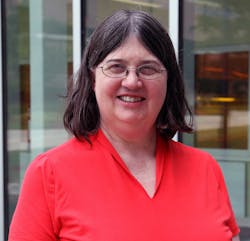By Karen Hanna
Undergraduate tuition at Ferris State University in Big Rapids, Mich., is about $13,000 a year, putting the sticker price of a four-year stint at more than $50,000.
Students who graduate with a degree in plastics engineering technology likely will make more than that in a year, with average salaries around $65,000 or $70,000, according to Marc Guske, coordinator/associate professor for the plastics and rubber engineering technologies programs. Many become process or project engineers; others pursue careers in design.
Instructors of college and university plastics programs say helping graduates find jobs isn’t as big a challenge as finding ways to get students to consider a career in the industry in the first place. Holding students back is the appeal of other engineering programs, as well as negative perceptions about plastics’ role in the environment, they say.
A white paper by Perc Pineda, chief economist for the Plastics Industry Association, projected the number of job openings for engineers — the highest-paid personnel in the plastics industry — to grow by 8.7 percent annually from 2016 to 2026. The study, “An Analysis of Workforce Development Issues in the U.S. Plastics Industry,” reported, on average, 71,500 annual job openings for engineers in the industry when it was published in 2019 — before the current nationwide labor shortage gripped the supply chain.
Employees in production occupations — jobs that typically require less skill or education than engineering roles — compose the largest portion of the plastics workforce, according to Pineda’s study. Engineers make up just 6.8 percent of the workforce, earning a national median wage of more than $100,000, according to the report’s analysis of U.S. Bureau of Labor Statistics data from 2019.
“Graduates with degrees in plastics engineering should expect a robust job market when they graduate, regardless of economic conditions,” the report states.
Compared to other engineering degrees, plastics isn’t the biggest draw, though, academic leaders said.
“We’re low, because of the bad press. We’re down to probably 40 kids per class in the undergraduate program,” Barry said. Class sizes have ranged as high as 60 students, she said.
To combat issues involving the industry’s image, Barry said her department is working with students in kindergarten through grade 12 to show a more positive side to plastics.
“I don’t think the industry has done a good job of leading, or putting out press to the general public that shows good things that are going on,” she said.
Barry said her department also tries to reach out to women and people of color, who are traditionally underrepresented in the industry.
Two factors are particularly influential in steering students toward a career in plastics, instructors said: A familiarity with the field, through family or friends, and the opportunity to see production up close.
Now program coordinator of the plastics engineering technology department at Penn State Erie, The Behrend College, where he earned his bachelor’s degree, Meckley has a master’s degree from Barry’s school — the University of Massachusetts Lowell.
For him, seeing was believing.
“I came from a mechanical engineering technology program, just happened to be walking down the steps one day and looked in the window in the old lab, and saw people there working, and I said I want to be part of that,” said Meckley, a member of the second graduating class from Penn State Erie, The Behrend College’s plastics program in 1990. “Then, our new lab, the one we’re in now, it’s got huge, massive windows that people can study next to, look in, walk by, look in, that kind of stuff, so, we’ve got a lot of interest from people who come to Behrend, maybe didn’t consider the program, but they see the activity that goes on in our lab, and they say, ‘I want to be part of that.’ ”
In selling their programs, Guske, Barry and Meckley returned to the same advantages of a career in plastics. Their graduates, they said, always land jobs in their field, pull down high pay and get to pursue hands-on opportunities as makers, fixers and doers.
“I think that’s really what makes our program so unique is most people when they think about college, they think big lecture halls and just sitting there and listening to lectures versus here at Ferris, we have, I think, nine injection molding machines right now, six extruders, some blow molders, robots ... software, so they’re actually in the lab on their feet making stuff,” Guske said.
Considering the apprehensions some young people have about the industry, Guske and Meckley both said they are able to attract students with the promise of a career that is designing the future.
As Guske tells students:
“The best thing that we can do, as plastics engineers, we’re the ones who are ultimately making the efforts to reduce how much plastic is used unnecessarily, and creating more sustainable products like lighter cars, medical devices.”
Karen Hanna, senior staff reporter
Contact:
Ferris State University, Big Rapids, Mich., 231-591-2000, www.ferris.edu/CET/design-mfg/plastics
Penn State Erie, The Behrend College, Erie, Pa., 814-898-6000, https://behrend.psu.edu/school-of-engineering/academic-programs/plastics-engineering-technology
Plastics Industry Association, Washington, D.C., 202-974-5200, www.plasticsindustry.org
University of Massachusetts Lowell, Lowell, Mass., 978-934-3420, www.uml.edu/engineering/plastics
About the Author
Karen Hanna
Senior Staff Reporter
Senior Staff Reporter Karen Hanna covers injection molding, molds and tooling, processors, workforce and other topics, and writes features including In Other Words and Problem Solved for Plastics Machinery & Manufacturing, Plastics Recycling and The Journal of Blow Molding. She has more than 15 years of experience in daily and magazine journalism.


